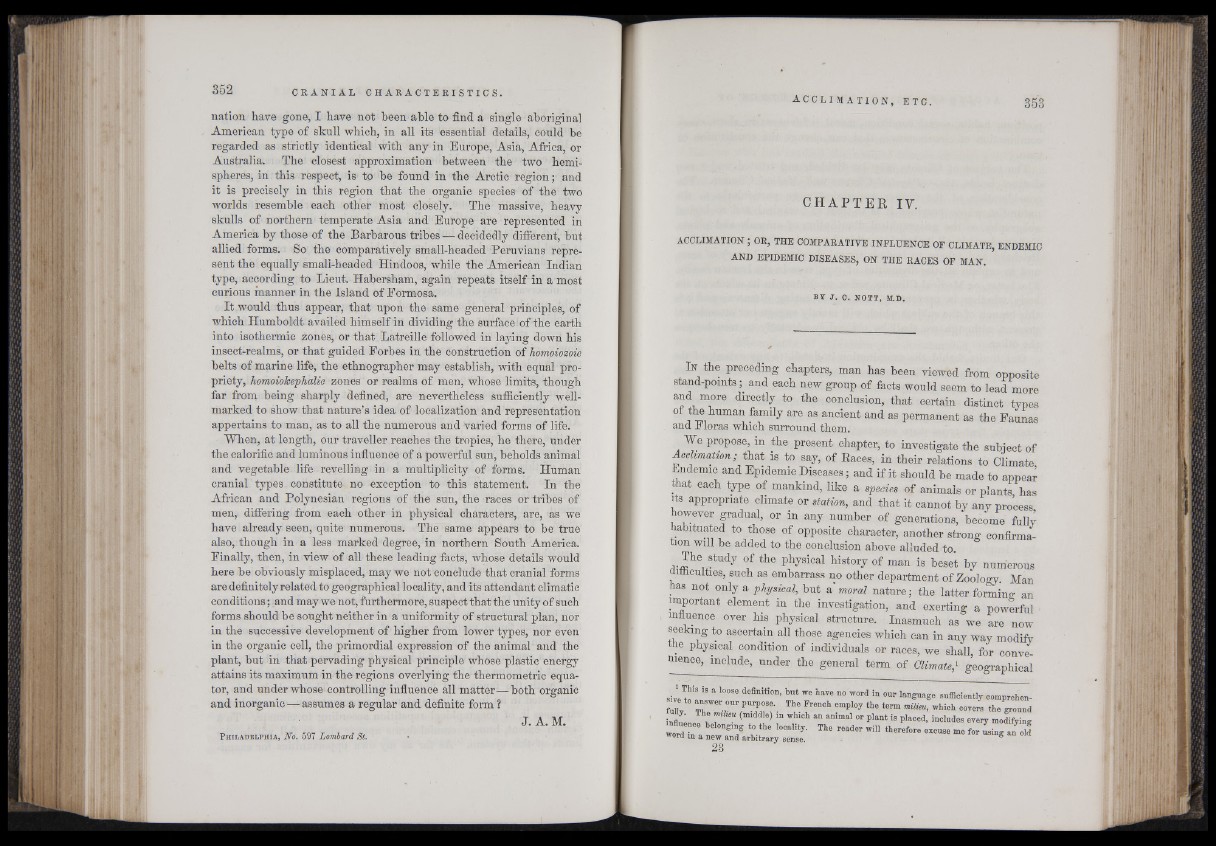
nation have gone, I have not been able to find a single aboriginal
American type of skull which, in all its essential details, could he
regarded as strictly identical with any in Europe, Asia, Africa, or
Australia. The closest approximation between the two hemispheres,
in this respect, is to be found in the Arctic region;-and
it is precisely in this region that the organic species of the two
worlds resemble each other most closely. The massive, heavy
skulls of northern temperate Asia and Europe are represented in
America by those of the Barbarous tribes — decidedly different, hut
allied forms. So the comparatively small-headed Peruvians represent
the equally small-beaded Hindoos, while the American Indian
type, according to Lieut. Habersham, again repeats itself in a most
curious manner in the Island of Formosa.
It would thus appear, that upon the same general principles, of
which Humboldt availed himself in dividing the surface i of the earth
into isothermic zones, or that Latreille followed in laying down his
insect-realms, or that guided Forbes in the construction of homoiozoic
belts of marine life, the ethnographer may establish, with equal propriety,
homoiokephalic zones or realms of men, whose limits, though
far from being sharply defined, are nevertheless sufficiently well-
marked to show that nature’s idea of localization and representation
appertains to man, as to all the numerous and varied forms of life.
When, at length, our traveller reaches the tropics, he there, under
the calorific and luminous influence of a powerful sun, beholds animal
and vegetable life revelling in a multiplicity of forms. Human
cranial types constitute no exception to this statement. In the
African and Polynesian regions of the sun, the races or tribes of
men, differing from each other in physical characters,, are, as we
have already seen, quite numerous. The same appears to he true
also, though in a less marked degree, in northern South America.
Finally, then, in view of all these leading facts, whose details would
here be obviously misplaced, may we not conclude that cranial forms
are definitely related to geographical locality, and its attendant climatic
conditions; and may we not, furthermore, suspect that the unity of such
forms should he sought neither in a uniformity of structural plan, nor
in the successive development of higher from lower types, nor even
in the organic cell, the primordial expression of the animal and the
plant, hut in that pervading physical principle whose plastic energy
attains its maximum in the regions overlying the thermometric equator,
and under whose controlling influence all matter— both organic
and inorganic — assumes a regular and definite form ?
J. A. M.
P h i l a d e l p h i a , N o. 597 Lombard St.
C H A P T E R IV.
ACCLIMATION; OR, THE COMPARATIVE INFLUENCE OF CLIMATE, ENDEMIC
AND EPIDEMIC DISEASES, ON THE RACES OF MAN.
BY J . O. NOTT, M.D.
In the preceding chapters, man has been viewed from opposite
stand-pomts ¡g and each new group of facts would seem to lead more
W Sb M directly to the conclusion, that certain distinct types
of the human family are as ancient and as permanent as the Faunas
and I loras which surround them.
We propose, m the present chapter, to investigate the subject of
Acclimation; that is to say, of Races, in their relations to Climate
Endemic and Epidemic Diseases; and if it should he made to appear
that each type of mankind, like a species of animals or plants has
its appropriate climate or station, and that it cannot by any process
owever gradual, or in any number of generations, become fully
habituated to those of opposite character, another strong confirmation
will he added to the conclusion above alluded to.
f the Physical hist0I7 of man is beset by numerous
aimculties, such as embarrass no other department of Zoology. Man
has not only a physical, hut a 'moral nature; the latter forming an
important element in the investigation, and exerting a powerful
influence over his physical structure. Inasmuch as we are now
seeking to ascertain all those agencies which can in any way modify
he physical condition of individuals or races, we shall, for convenience,
include, under the general term of Olimate,1 geographical
I W 18 a 10036 defimtl0n> S ™ haTO 110 v o rd in onr la n ^ a g e sufficiently comprehenrX
m m &i x “ empioy tbe tem * * * * 5 S E
!nflL o \ ™ (middle) m wtlel1 an ammal OT P ^ n t is placed, includes eve ry modifying 3 1 S i H l0°ality- Th6 r6ad6r wil1 ‘W o r e 111 ™ me for using an old a new and arbitrary sense.
28